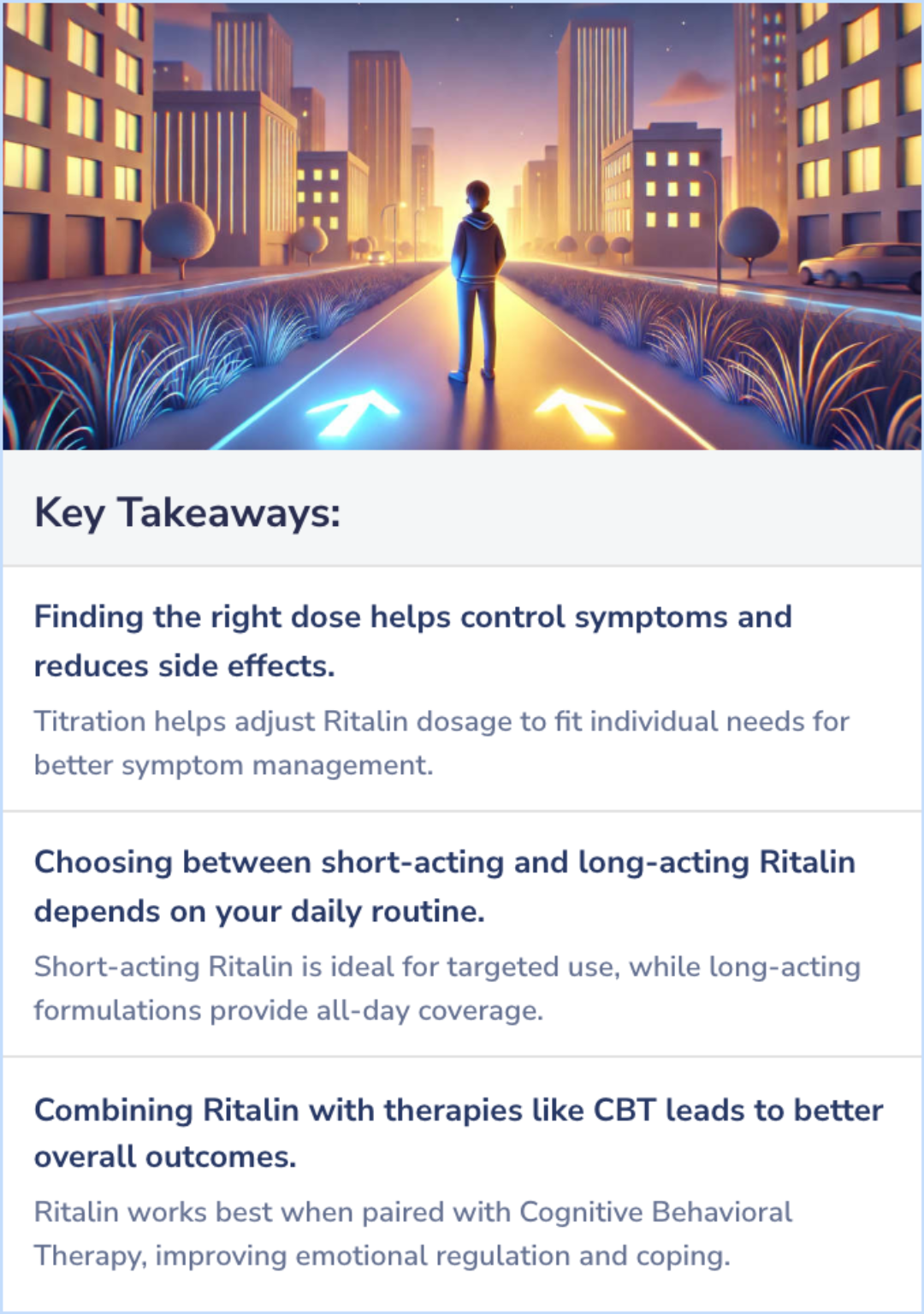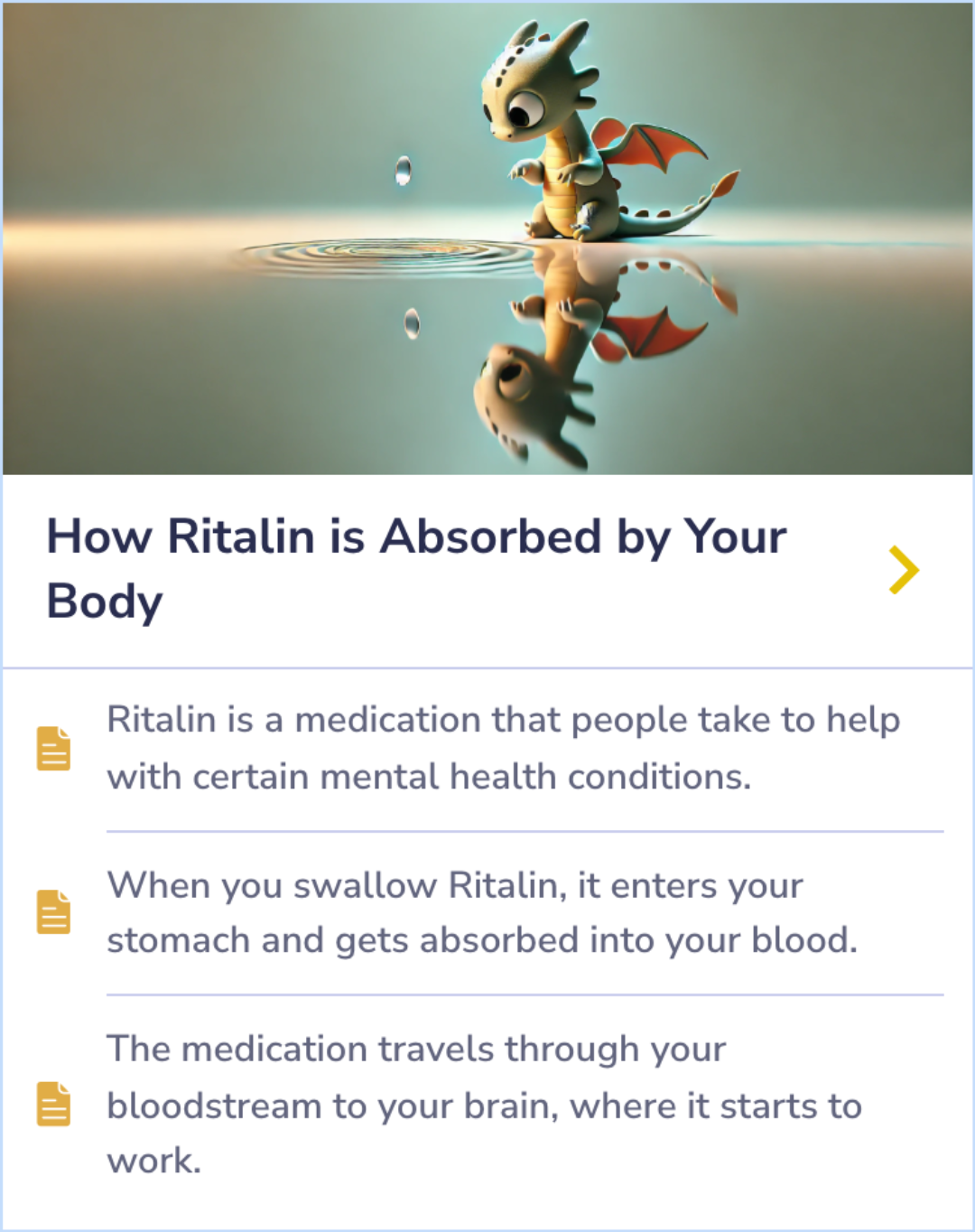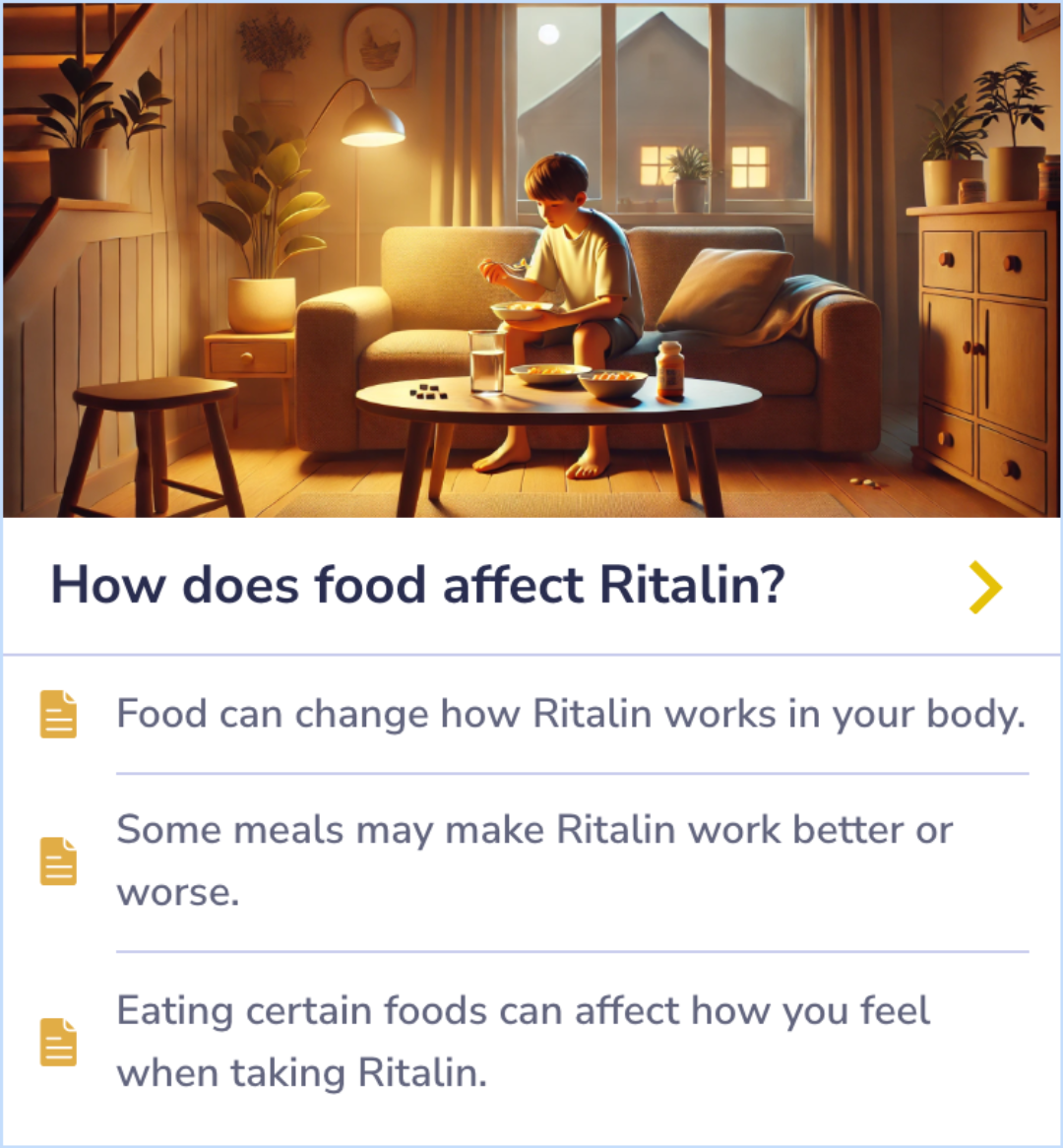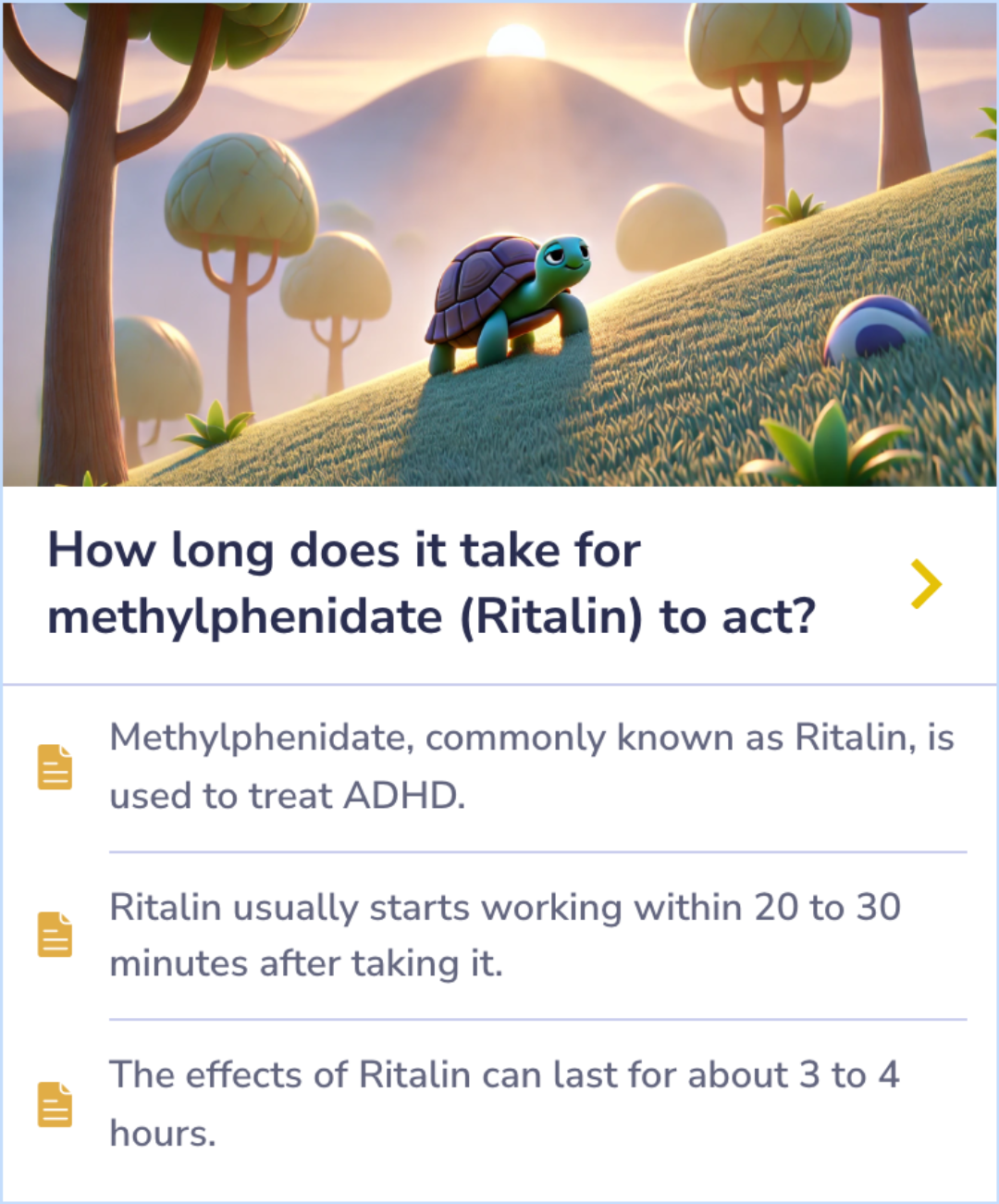Ritalin
Evidence Based Answers
What makes Ritalin work better?
Effective Ritalin use involves tailored dosing, selecting the right formulation, and combining with supportive therapies like CBT to manage symptoms and improve outcomes.
Published: October 20, 2024
Click to explore a section:

Using Ritalin effectively includes finding the right dose, formulation, and combining with therapies.
Finding the Right Dose for Maximum Efficacy
Everyone responds differently to Ritalin, so finding the correct dose requires a process called titration. This approach helps determine the dose that works best for managing ADHD symptoms while minimizing side effects.
This process leads to more consistent symptom control and fewer side effects, such as appetite loss or sleep issues.
This process leads to more consistent symptom control and fewer side effects, such as appetite loss or sleep issues.
“
Source Quotes:
Titration of MPH is a process of trial-and-error, considering significant individual differences with respect to optimal dose requirements.
Choosing the Right Formulation: Short- vs Long-Acting
Ritalin comes in both short-acting and long-acting forms. Short-acting formulations provide quick symptom relief but require multiple doses throughout the day. Long-acting formulations offer all-day coverage with fewer doses.
The choice depends on lifestyle and symptom patterns. Short-acting Ritalin may be better for targeted periods, while long-acting versions provide sustained control with less frequent dosing.
The choice depends on lifestyle and symptom patterns. Short-acting Ritalin may be better for targeted periods, while long-acting versions provide sustained control with less frequent dosing.
“
Source Quotes:
Long-acting MPH capsules combine IR and ER formulations, ensuring rapid onset and durability of clinical effects.
Choice of stimulant preparation depends on time to onset, desired effect, and lifestyle factors. Some prefer short-acting drugs for targeted periods, while others prefer long-acting for all-day control.
Combining Ritalin with Non-Pharmacologic Therapies
Research shows that Ritalin works well when combined with non-pharmacologic therapies like Cognitive Behavioral Therapy (CBT). CBT can help with organizational skills, emotional regulation, and coping strategies, complementing the medication’s effects.
This combined approach leads to better outcomes, such as improved self-esteem and social functioning.
This combined approach leads to better outcomes, such as improved self-esteem and social functioning.
“
Source Quotes:
Patients with ADHD managed on both medication and non-pharmacologic treatments have shown higher self-esteem and social functioning skills versus those untreated.
Medication clearly augmented the benefit of CBT in one randomized, controlled study. Results strongly suggest combining stimulant medication with CBT is better than either treatment alone.
Timing and Adjusting Doses for Best Results
The timing of Ritalin doses can affect how well it controls symptoms. Taking it before meals or adjusting the schedule to match activity levels can improve its effects.
Adjusting the dose based on daily needs helps maintain consistent symptom control throughout the day.
Adjusting the dose based on daily needs helps maintain consistent symptom control throughout the day.
“
Source Quotes:
Food may delay the peak effects of MPH by about 1 hour, but its overall effectiveness remains unchanged.
A constant serum concentration did not maintain full efficacy, suggesting acute tolerance. A rising concentration can counteract tolerance and maintain efficacy for up to 12 hours.
Key Takeaways
Conclusions
Finding the right dose through titration ensures Ritalin provides the best symptom control with minimal side effects, making it a key step in effective management. Pairing this with the appropriate formulation—short-acting for specific times or long-acting for all-day coverage—helps fit treatment into daily life.
Combining Ritalin with non-drug therapies like Cognitive Behavioral Therapy improves outcomes, addressing emotional and social needs. Timing and adjusting doses further optimize symptom management, ensuring better day-to-day control.
Combining Ritalin with non-drug therapies like Cognitive Behavioral Therapy improves outcomes, addressing emotional and social needs. Timing and adjusting doses further optimize symptom management, ensuring better day-to-day control.

Evidence Summary
How Ritalin Travels from the Stomach to the Brain
Ritalin, a medication used for ADHD, enters the body through the stomach and is absorbed into the bloodstream. It then travels to the brain where it starts to manage symptoms like attention and impulse control. The medication works quickly to begin its effect, making it a reliable option for many.
From the stomach to the brain, Ritalin is designed to help with focus and mental health by traveling through the bloodstream to reach its target efficiently.
From the stomach to the brain, Ritalin is designed to help with focus and mental health by traveling through the bloodstream to reach its target efficiently.
Evidence Summary
How Food Influences Ritalin's Effects
Food can affect how Ritalin works in the body, sometimes enhancing or reducing its effectiveness. What you eat may also influence how you feel while taking the medication.
Certain meals might make Ritalin more effective, while others could lessen its impact. This can lead to changes in how well it manages symptoms or how long the effects last throughout the day.
Certain meals might make Ritalin more effective, while others could lessen its impact. This can lead to changes in how well it manages symptoms or how long the effects last throughout the day.
Evidence Summary
Ritalin's Effects and Duration
Ritalin, used to treat ADHD, starts working within 20 to 30 minutes after taking it. The effects last for about 3 to 4 hours, making it necessary to plan dosing schedules around daily activities.
This timing is important to note when managing tasks that require focus throughout the day, as the short duration may lead to needing multiple doses to maintain effectiveness over time.
This timing is important to note when managing tasks that require focus throughout the day, as the short duration may lead to needing multiple doses to maintain effectiveness over time.


